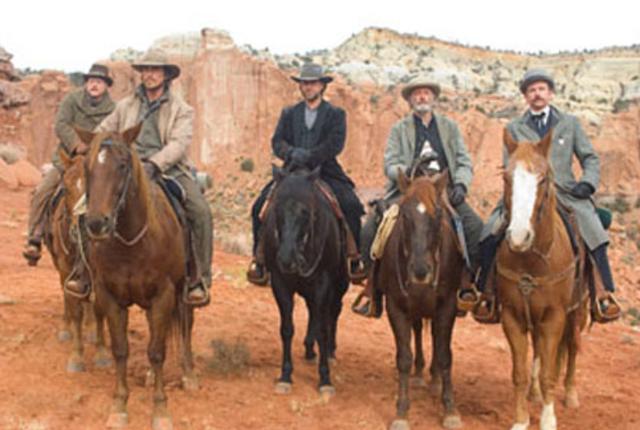New Mexico’s striking landscapes and distinctive cultural backdrop have made it a favored setting for filmmakers throughout the 21st century. From sprawling deserts to vibrant urban scenes, the state has provided an authentic canvas for a diverse array of movies spanning multiple genres. In this article, we present a curated list of notable films set in New Mexico that have graced screens over the past two decades, showcasing the region’s growing prominence in contemporary cinema.
Top Movies Set in New Mexico Showcasing the State’s Unique Landscapes
New Mexico’s rugged deserts, vibrant mesas, and sprawling adobe towns have provided an iconic backdrop for many acclaimed films of the 21st century. From intense dramas to gripping thrillers, these movies use the state’s distinctive landscapes not only as a setting but as a character in their own right, enriching the narrative with a palpable sense of place. Directors are drawn to New Mexico’s unique blend of natural beauty and cultural richness, which lends authenticity and visual depth to every scene shot here.
Among the standout productions are films that exploit the state’s diverse environments-from Albuquerque’s urban sprawl to the remote stretches of the Chihuahuan Desert. The stark contrasts create a cinematic canvas that’s both haunting and breathtaking. Below is a snapshot of notable films that capture the essence of New Mexico’s terrain and spirit:
- Breaking Bad (2008-2013): While technically a TV series, its cinematic quality and New Mexico’s gritty urban and desert landscapes have become inseparable from the story.
- No Country for Old Men (2007): Featuring the expansive borderlands, this film’s suspense is amplified by the isolation of New Mexico’s open spaces.
- The Lone Ranger (2013): Showcases New Mexico’s rugged wilderness and historical towns, blending Western mythology with natural grandeur.
- Hell or High Water (2016): Uses rural New Mexico settings to amplify the film’s exploration of economic hardship and resilience.
| Film | Setting Highlight | Year Released |
|---|---|---|
| Wind River | Snow-covered plains, Native American reservation | 2017 |
| Logan | Desolate desert outskirts | 2017 |
| 3:10 to Yuma | Small town and rugged canyons | 2007 |
| Chef | Urban Albuquerque food scene | 2014 |
How New Mexico’s Culture Influences Storytelling in 21st Century Films
New Mexico’s rich tapestry of indigenous heritage, Hispanic influences, and rugged Southwestern landscapes deeply shapes the narratives of contemporary films set in the region. Filmmakers often incorporate the state’s vibrant cultural motifs, from traditional Pueblo pottery designs to centuries-old storytelling customs, weaving these elements into stories that explore identity, community, and resilience. This cultural specificity offers a unique backdrop that distinguishes New Mexico-based films from typical Hollywood productions, infusing them with authenticity and depth.
Beyond aesthetics, the blending of cultures often introduces themes of coexistence and transformation, reflected through characters and plotlines. Stories frequently highlight tensions between modernization and tradition, the sacred and the secular, or the visible and the mystical. This interplay is exemplified in films that balance Navajo legends or Hispanic folklore with contemporary issues, thereby providing audiences with a cinematic experience that is as educational as it is compelling.
- Emphasis on Landscape: The desert, mesas, and adobe architecture serve as silent narrators.
- Multilingual Dialogue: Spanish, Navajo, and English converge to reflect real conversations.
- Spiritual Underpinnings: Rituals and symbolism often drive story arcs.
| Cultural Element | Storytelling Impact |
|---|---|
| Native American Mythology | Introduces mystical themes and moral lessons |
| Hispanic Traditions | Highlights family dynamics and historical context |
| Southwestern Scenery | Creates atmosphere and symbolic visual cues |
Must-Watch Films Filmed in New Mexico Highlighting Local Talent and Locations
New Mexico’s diverse landscapes and vibrant culture have become a magnetic backdrop for filmmakers seeking authenticity and local flair. Titles such as “No Country for Old Men” and “The Book of Eli” showcase the state’s rugged deserts and sprawling vistas while featuring emerging talent from nearby communities. In recent years, the rise of local productions has nurtured a growing pool of actors, crew members, and creatives whose deep connection to New Mexico adds a unique texture to each project. These films not only highlight cinematic excellence but also spotlight the rich heritage and evolving stories rooted in the Land of Enchantment.
Below is a glimpse of standout features that have embraced New Mexico’s landscape and local artists, contributing to the growing film industry in the state:
- “Hell or High Water” (2016) – With scenes shot across Albuquerque and surrounding towns, it combines suspenseful storytelling with authentic Southwestern grit.
- “Wind River” (2017) – Filmed partially in the state, it amplifies local voice and talent in telling gripping tales set in harsh terrains.
- “Logan” (2017) – The Wolverine’s journey is framed against New Mexico’s stark beauty, with supporting roles filled by regional actors.
| Film | Location Highlights | Local Talent Features |
|---|---|---|
| No Country for Old Men | Santa Fe Desert, Marfa | Regional extras, crew from Albuquerque |
| The Book of Eli | White Sands, Roswell | Local stunt coordinators |
| Hell or High Water | Albuquerque, Las Cruces | New Mexican supporting actors |
In Summary
From iconic blockbusters to independent gems, New Mexico’s diverse landscapes and vibrant culture have made it a favored backdrop for filmmakers throughout the 21st century. As this list highlights, the state continues to play a significant role in bringing a variety of stories to the big screen, reflecting its growing importance in the film industry. Whether you’re a movie enthusiast or a local proud of New Mexico’s cinematic presence, these films offer a unique lens through which to appreciate the state’s contribution to contemporary cinema.
